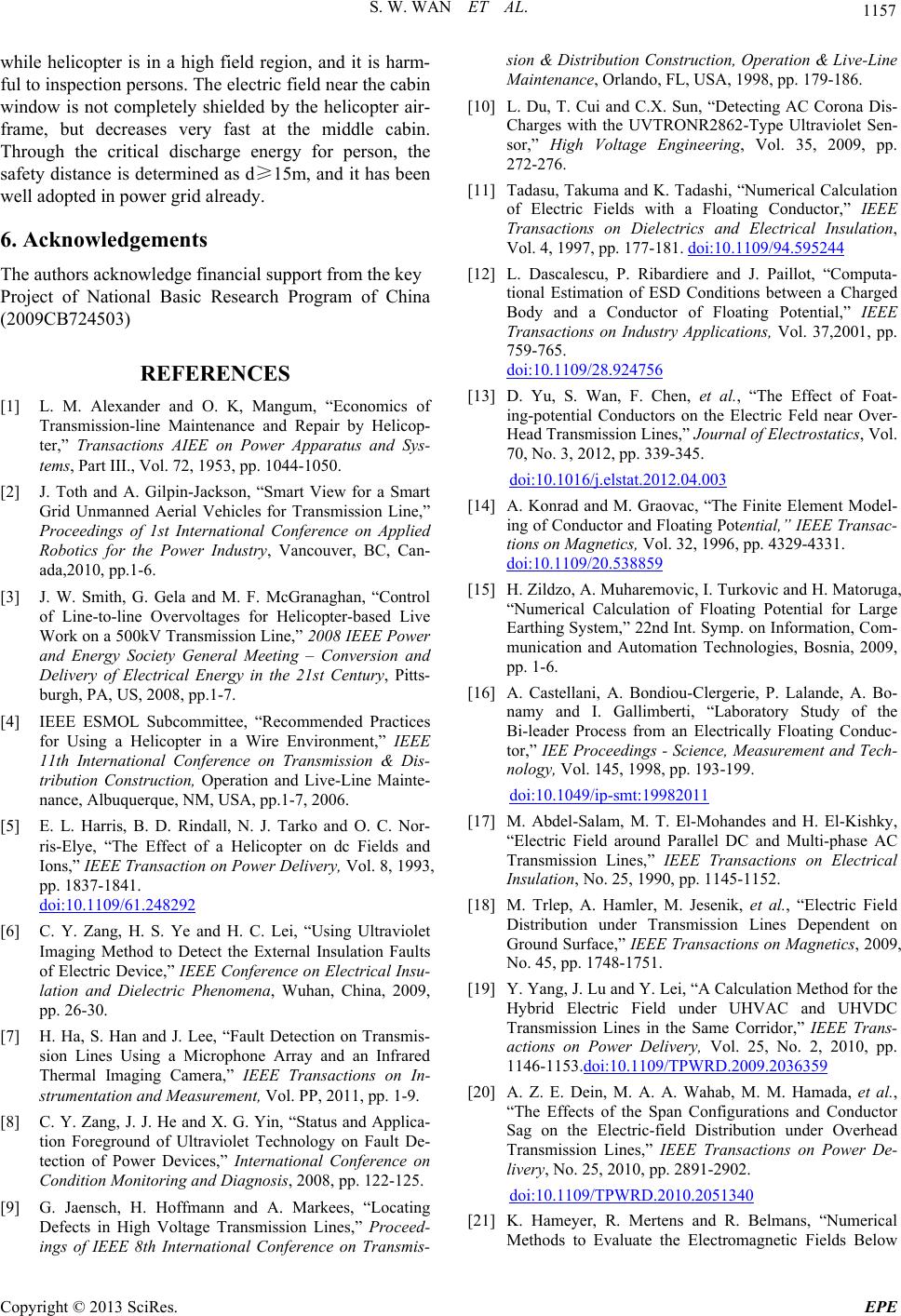
S. W. WAN ET AL. 1157
while helicopter is in a high field region, and it is harm-
ful to inspection persons. Th e electric field near the cabin
window is not completely shielded by the helicopter air-
frame, but decreases very fast at the middle cabin.
Through the critical discharge energy for person, the
safety distance is determined as d≥15m, and it has been
well adopted in power grid already.
6. Acknowledgements
The authors acknowledge financial support from the key
Project of National Basic Research Program of China
(2009CB724503)
REFERENCES
[1] L. M. Alexander and O. K, Mangum, “Economics of
Transmission-line Maintenance and Repair by Helicop-
ter,” Transactions AIEE on Power Apparatus and Sys-
tems, Part III., Vol. 72, 1953, pp. 1044-1050.
[2] J. Toth and A. Gilpin-Jackson, “Smart View for a Smart
Grid Unmanned Aerial Vehicles for Transmission Line,”
Proceedings of 1st International Conference on Applied
Robotics for the Power Industry, Vancouver, BC, Can-
ada,2010, pp.1-6.
[3] J. W. Smith, G. Gela and M. F. McGranaghan, “Control
of Line-to-line Overvoltages for Helicopter-based Live
Work on a 500kV Transmission Line,” 2008 IEEE Power
and Energy Society General Meeting – Conversion and
Delivery of Electrical Energy in the 21st Century, Pitts-
burgh, PA, US, 2008, pp.1-7.
[4] IEEE ESMOL Subcommittee, “Recommended Practices
for Using a Helicopter in a Wire Environment,” IEEE
11th International Conference on Transmission & Dis-
tribution Construction, Operation and Live-Line Mainte-
nance, Albuquerque, NM, USA, pp.1-7, 2006.
[5] E. L. Harris, B. D. Rindall, N. J. Tarko and O. C. Nor-
ris-Elye, “The Effect of a Helicopter on dc Fields and
Ions,” IEEE Transaction on Power Delivery, Vol. 8, 1993,
pp. 1837-1841.
doi:10.1109/61.248292
[6] C. Y. Zang, H. S. Ye and H. C. Lei, “Using Ultraviolet
Imaging Method to Detect the External Insulation Faults
of Electric Device,” IEEE Conference on Electrical Insu-
lation and Dielectric Phenomena, Wuhan, China, 2009,
pp. 26-30.
[7] H. Ha, S. Han and J. Lee, “Fault Detection on Transmis-
sion Lines Using a Microphone Array and an Infrared
Thermal Imaging Camera,” IEEE Transactions on In-
strumentation and Measurement, Vol. PP, 2011, pp. 1-9.
[8] C. Y. Zang, J. J. He and X. G. Yin, “Status and Applica-
tion Foreground of Ultraviolet Technology on Fault De-
tection of Power Devices,” International Conference on
Condition Monitoring and Diagnosis, 2008, pp. 122-125.
[9] G. Jaensch, H. Hoffmann and A. Markees, “Locating
Defects in High Voltage Transmission Lines,” Proceed-
ings of IEEE 8th International Conference on Transmis-
sion & Distribution Construction, Operation & Live-Line
Maintenance, Orlando, FL, USA, 1998, pp. 179-186.
[10] L. Du, T. Cui and C.X. Sun, “Detecting AC Corona Dis-
Charges with the UVTRONR2862-Type Ultraviolet Sen-
sor,” High Voltage Engineering, Vol. 35, 2009, pp.
272-276.
[11] Tadasu, Takuma and K. Tadashi, “Numerical Calculation
of Electric Fields with a Floating Conductor,” IEEE
Transactions on Dielectrics and Electrical Insulation,
Vol. 4, 1997, pp. 177-181. doi:10.1109/94.595244
[12] L. Dascalescu, P. Ribardiere and J. Paillot, “Computa-
tional Estimation of ESD Conditions between a Charged
Body and a Conductor of Floating Potential,” IEEE
Transactions on Industry Applications, Vol. 37,2001, pp.
759-765.
doi:10.1109/28.924756
[13] D. Yu, S. Wan, F. Chen, et al., “The Effect of Foat-
ing-potential Conductors on the Electric Feld near Over-
Head Transmission Lines,” Journal of Electrostatics, Vol.
70, No. 3, 2012, pp. 339-345.
doi:10.1016/j.elstat.2012.04.003
[14] A. Konrad and M. Graovac, “The Finite Element Model-
ing of Conductor and Floating Potential,” IEEE Transac-
tions on Magnetics, Vol. 32, 1996, pp. 4329-4331.
doi:10.1109/20.538859
[15] H. Zildzo, A. Muharemovic, I. Turkovic and H. Matoruga,
“Numerical Calculation of Floating Potential for Large
Earthing System,” 22nd Int. Symp. on Information, Com-
munication and Automation Technologies, Bosnia, 2009,
pp. 1-6.
[16] A. Castellani, A. Bondiou-Clergerie, P. Lalande, A. Bo-
namy and I. Gallimberti, “Laboratory Study of the
Bi-leader Process from an Electrically Floating Conduc-
tor,” IEE Proceedings - Science, Measurement and Tech-
nology, Vol. 145, 1998, pp. 193-199.
doi:10.1049/ip-smt:19982011
[17] M. Abdel-Salam, M. T. El-Mohandes and H. El-Kishky,
“Electric Field around Parallel DC and Multi-phase AC
Transmission Lines,” IEEE Transactions on Electrical
Insulation, No. 25, 1990, pp. 1145-1152.
[18] M. Trlep, A. Hamler, M. Jesenik, et al., “Electric Field
Distribution under Transmission Lines Dependent on
Ground Surface,” IEEE Transactions on Magnetics, 2009,
No. 45, pp. 1748-1751.
[19] Y. Yang, J. Lu and Y. Lei, “A Calculation Method for the
Hybrid Electric Field under UHVAC and UHVDC
Transmission Lines in the Same Corridor,” IEEE Trans-
actions on Power Delivery, Vol. 25, No. 2, 2010, pp.
1146-1153.doi:10.1109/TPWRD.2009.2036359
[20] A. Z. E. Dein, M. A. A. Wahab, M. M. Hamada, et al.,
“The Effects of the Span Configurations and Conductor
Sag on the Electric-field Distribution under Overhead
Transmission Lines,” IEEE Transactions on Power De-
livery, No. 25, 2010, pp. 2891-2902.
doi:10.1109/TPWRD.2010.2051340
[21] K. Hameyer, R. Mertens and R. Belmans, “Numerical
Methods to Evaluate the Electromagnetic Fields Below
Copyright © 2013 SciRes. EPE